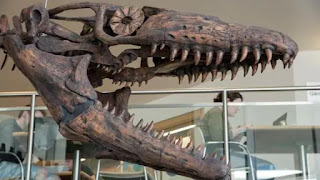The discovery of magnificent relics of a huge marine lizard 66 million years ago explains how this ancient extinct beast would have ruled the water.
The beast is a new species of mosasaur, which were huge marine reptiles that hunted the waters during the Late Cretaceous period.
It's known as Thalassotitan atrox, and wear on its teeth, as well as other bones discovered at its excavation site, indicate that this imposing animal was no gentle giant, but instead hunted difficult food like sea turtles, plesiosaurs, and other mosasaurs.
Other mosasaurs hunted smaller prey such as fish or ammonites (which weren't always that small).
Other mosasaurs hunted smaller prey such as fish or ammonites (which weren't always that small).
This implies that Thalassotitan likely occupied a position at the very top of the food chain, preserving habitats by keeping other predators in check.
You May Also Like To Read::Celebration Of International cat day
You May Also Like To Read:Dead By Daylight- Albert Wesker and Ada Wong
You May Also Like To Read: Soulja Boy’s Teeth Transformation- Twitter
"Thalassotitan was an extraordinary, scary animal," says Nick Longrich, a palaeontologist and evolutionary scientist at the University of Bath in the United Kingdom. "Imagine a Komodo dragon crossbred with a great white shark, a T. rex, and a killer whale."
There is no living reptile on the scale of mosasaurs, which could grow to be 12 metres (40 feet) long - twice the size of the largest extant reptiles, crocodilians. Mosasaurs, on the other hand, are distantly related to modern snakes and iguanas.
Mosasaurs were more adapted to a wholly aquatic lifestyle than the Galapagos marine iguanas. They had a reptile head, but flippers instead of clawed feet, and shark-like fins on their tail.


Comments
Post a Comment